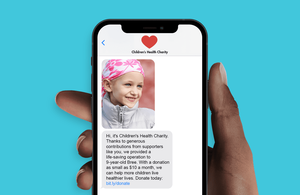Text Messages That Make a Difference: Proven SMS Strategies for Nonprofit Outreach
Body
In an age of digital saturation, where inboxes overflow and social media algorithms bury posts, one communication channel continues to cut through the noise: SMS. Text messaging delivers unmatched visibility, speed, and simplicity—making it one of the most underused but high-potential tools in nonprofit outreach.
For nonprofits, the goal is always impact. That means reaching donors, volunteers, and advocates in ways that actually prompt action. Text messages, when used thoughtfully, do just that. Whether it's raising emergency funds, rallying volunteers, or updating supporters on progress, SMS delivers timely, human-centered engagement that emails often miss.
Let’s break down proven SMS strategies that are helping nonprofits connect, convert, and create change.
Why SMS Works for Nonprofits
Before diving into tactics, it’s worth understanding the core advantages of SMS:
-
Open rates over 90% (compared to ~20% for email)
-
Most messages read within 3 minutes
-
Frictionless engagement—no app download, no login, no distractions
-
Universally accessible—works on any mobile phone
The combination of reach and immediacy makes SMS a powerful tool for any nonprofit’s communication stack.
Strategy #1: Use SMS for Time-Sensitive Appeals
Whether it’s a disaster relief drive or Giving Tuesday, urgency is critical. SMS excels when speed and timing matter. For example:
“We’re $3,000 short of today’s goal—your gift can help us cross the finish line. Tap to give: [link]”
These messages are ideal for:
-
Last-day reminders for fundraising campaigns
-
Breaking news updates that relate to your cause
-
Rapid response appeals following emergencies
Keep the message concise and include a single, clear call-to-action.
Strategy #2: Personalize Your Outreach
People give to people, not institutions. SMS works best when it feels like a message from a friend, not a broadcast from a brand. Use merge tags to personalize texts with first names or donation history:
“Hi Sarah, your support last month helped us deliver meals to 500 families. Can you help us again today? [link]”
Tips:
-
Speak like a human, not a marketer
-
Limit character count to around 160 per message
-
Use informal, warm language (“Hey,” “Thanks,” “We’re almost there!”)
Strategy #3: Automate Donor Journeys
Set up automated SMS workflows based on donor behavior or lifecycle stage. For instance:
-
After first donation: “Thanks for your gift! Here’s how you made an impact: [link]”
-
One month later: “Want to see your impact grow? Monthly giving helps us plan better. [link]”
-
Before a renewal date: “Hi Alex—just a reminder, your monthly gift is renewing soon. Thanks again!”
Automation ensures consistent touchpoints without overwhelming your team. Most platforms like Rally Corp, Twilio, and MobileCause offer this functionality.
Strategy #4: Coordinate Volunteers in Real Time
Need to shift volunteers to a new location? Short on help for an event? Use SMS to mobilize people fast.
“We could use 3 more helpers at the main tent. If you’re nearby, reply YES!”
Because texts are checked quickly, you can adapt on the fly—especially useful during large events or on-the-ground relief work.
Pro tip: Use keywords or shortcodes to create quick signup flows. E.g., “Text VOLUNTEER to 88888 to get updates.”
Strategy #5: Share Stories, Not Just Appeals
Not every text should ask for something. Use SMS to close the feedback loop and make supporters feel like part of your mission.
“You helped us build a new well! Here’s a short video showing the community’s reaction: [link]”
Think of it as story-driven stewardship. Celebrating wins keeps people emotionally invested and more likely to give again.
Strategy #6: Ask for Feedback
Two-way SMS allows you to engage supporters in quick, meaningful ways. Example:
“How did we do at Saturday’s cleanup event? Reply 1-5, with 5 being excellent.”
You can also ask open-ended questions or poll your base:
“Which issue should we prioritize this month: A) Food security, B) Shelter, C) Advocacy?”
This not only boosts engagement—it shows your community their voice matters.
Strategy #7: Re-Engage Lapsed Donors
Someone gave once, then disappeared? A quick, respectful check-in via SMS can bring them back.
“Hey Jamie—we’ve missed you! Want to see what’s new since your last gift? [link]”
This message should:
-
Feel personal, not automated
-
Offer value (updates, stories, impact)
-
Make re-engagement easy (mobile-friendly links, tap-to-donate options)
Segmenting lapsed donors and sending tailored messages based on donation history increases response rates significantly.
Strategy #8: Use Keywords to Segment Audiences
Let supporters opt into specific interest areas by texting keywords. This helps you target future messages more effectively.
Examples:
-
“Text CLIMATE to 55555 to get our latest updates on environmental campaigns.”
-
“Text PETS to 55555 to join our animal rescue alerts.”
This strategy turns one list into multiple micro-communities, each with higher engagement.
Strategy #9: Measure, Test, Improve
Track these SMS metrics:
-
Delivery rate (successful sends)
-
Open rate (often assumed high)
-
Click-through rate (CTR)
-
Response rate (for two-way messages)
-
Unsubscribe rate
Run A/B tests on:
-
Message length
-
CTA placement
-
Use of emojis or urgency
-
Sending time (morning, midday, evening)
Use insights to optimize. For example, if reminders at 5 PM outperform morning sends, adjust your schedule accordingly.
Compliance: Get It Right From the Start
SMS is governed by regulations like the Telephone Consumer Protection Act (TCPA). Nonprofits must still follow consent rules.
Checklist:
-
Use a clear opt-in method (checkbox on donation forms, keyword opt-ins)
-
Send a confirmation message (e.g., “You’re subscribed to [Org]. Msg&data rates may apply. Text STOP to opt out.”)
-
Honor opt-outs immediately
-
Avoid sending outside reasonable hours (typically 8 AM–8 PM)
Treating your list with care preserves trust and reduces opt-outs.
Final Thought: SMS Is a Conversation, Not a Megaphone
SMS isn’t just about pushing out messages. It’s about creating connection. That connection, when nurtured, leads to deeper involvement—more volunteers, higher donation frequency, and greater lifetime value.
The nonprofits winning with SMS aren’t sending more—they’re sending better. They treat it like a conversation, not a campaign. And that mindset shift is what makes the difference.






Comments